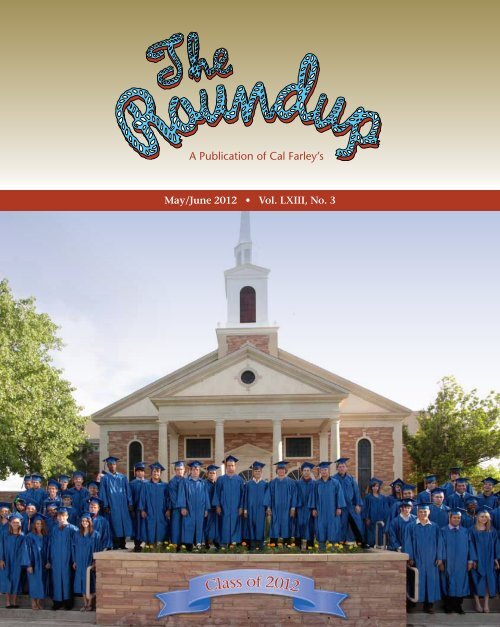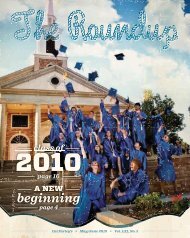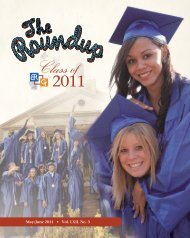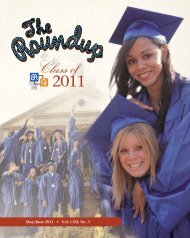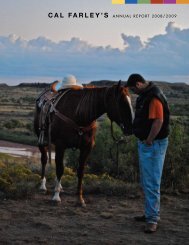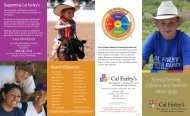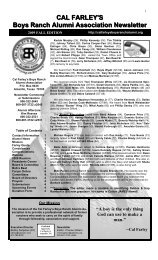The Roundup Summer 2012 - Cal Farley's
The Roundup Summer 2012 - Cal Farley's
The Roundup Summer 2012 - Cal Farley's
You also want an ePaper? Increase the reach of your titles
YUMPU automatically turns print PDFs into web optimized ePapers that Google loves.
A Publication of <strong>Cal</strong> Farley’sMay/June <strong>2012</strong> • Vol. LXIII, No. 3
Table ofContentsHow Horses Help to Heal..................2<strong>The</strong> Proof is in the Puddin’................3Hope and a Future..............................5Class of <strong>2012</strong>.......................................7Graduation Day..................................9Out of the Darkness.........................11Happy 40 th Anniversary...................13A New Era Began..............................14Note to Donors“Thank you for all theopportunities your giving hasafforded me. My success ofgraduating high school wouldnot be possible without you.”– Kendall Higgins, a Boys Ranch High SchoolClass of <strong>2012</strong> graduateMilestonesand RelationshipsJohn W. Gardner was once quoted as saying, “We arecontinually faced with a series of great opportunitiesbrilliantly disguised as insoluble problems.” This quote, tome, reflects one of the most important principles of our workat <strong>Cal</strong> Farley’s: to help young people turn the seeminglyinsurmountable problems in their lives into opportunities.I can’t think of a better time to highlight this theme thanon the threshold of high school graduation. This year, 55students received their high school diplomas through ourprograms. Many of these students might have thought at some point they didn’t have a chanceat realizing this dream, and it probably would be safe to say that some of the people aroundthem had that same inclination.In <strong>Cal</strong> Farley’s programs, however, we believe a child is a gift from God, and as such, hastremendous inherent potential just waiting to be tapped. <strong>The</strong> key to helping a child unleashtheir potential is through a meaningful, guided and trustworthy relationship. So, behind everyyoung person you read about in this issue of <strong>The</strong> <strong>Roundup</strong>, there are caring and knowledgeableadults encouraging them along the way.Graduate Joe Teachout is a fine example of this. Joe isn’t a “super star” athlete, but he is ahard-working young man with a lot of heart. He nevertheless competed in not only one, buttwo Texas state-level sporting competitions – one resulting in a championship – during thisschool year, and that is due in large part because of one man, his coach Kenneth Brown, whorecognized Joe’s potential and helped him to discover that potential in himself.Our staff plays a vital role in all we do and that is why we share with you the story of therecent employment anniversary of Dennis and Nancy McNeill. <strong>The</strong>y have been taking careof young people at <strong>Cal</strong> Farley’s Boys Ranch for 40 years! My goodness, just think of all themeaningful relationships they have fostered over these many years, and the lives of childrenthey have influenced.Another significant milestone we celebrate is that of integrating girls as a part of the BoysRanch census. It was 20 years ago this summer that the <strong>Cal</strong> Farley’s Board of Directors madethat culture-changing decision and selected nine girls from the <strong>Cal</strong> Farley’s Girlstown, U.S.A.campus to live at Boys Ranch. <strong>The</strong> girls were afforded the opportunity to further strengthenthe bond with their brothers already on campus. Today, 20 years later, on campus we have82 girls, some representing 11 sibling groups, who are growing and thriving at Boys Ranch– together.Yes, every year in <strong>Cal</strong> Farley’s programs we celebrate milestones and relationships thatchange – for the better – the lives of our young people forever. We are blessed to be a part ofthis amazing work! Thank you for being such a special part of it all, too.P.O. Box 1890, Amarillo, Texas 79174-0001(800) 687-3722 • www.calfarley.org<strong>Roundup</strong> StaffBoard of Directors and Advisory Board MembersDan AdamsPresident and CEO<strong>Roundup</strong> EditorCommunications InternJennifer HarkerLauren SheltonTom Roach (Chair), Lenny Sadler (Vice-Chair), Rodney Ruthart (Treasurer), Lilia Escajeda (Secretary), Dan Adams (ExOfficio) Tanner Alexander, Tom Bivins, Tom Blakemore, Betty Cooper, Harold Courson, Joe Howell, Bud Joyner, JaneKing, Mike King, Debra McCartt, Greg Mitchell, Fay Moore, Walter “Four” Price, Jerry Raines, Alan Roberson, J. AveryRush III, Shannon Stapp, Chris Storm, Billy Attebury, Coney Burgess, Ed Fancher, Bettye Green, Genie Farley Harriman,Sherm Harriman, Gene Hayman, Virginia Maynard, Rosemary Roach and Lamont Waldrip.1Cover photo by Davy Knapp Photography©<strong>2012</strong> <strong>Cal</strong> Farley’s – CALFAR 26204
EquineProgramsHow Horses Help to Heal<strong>The</strong> transformation that can occur between a child and a horse can prove nothing short ofmiraculous. Life-long lessons about relationships are taught to the children and youth of <strong>Cal</strong>Farley’s through use of the equine species.Horses teach our children about self-control, patience, how to establish a healthy relationship,how to work through feelings of anger and frustration, and most importantly, how to establish aloving and giving relationship.Recently, for example, while working with a boy, the counselor and horseprofessional experienced a breakthrough. This preadolescent boy had in hisshort life experienced significant trauma and great loss. Though he is notyet ready to fully face his grief, through equine-assisted psychotherapy, staffmembers are able to work on his ability to ask for help.<strong>The</strong> boy, bareback atop a horse, could not in this one instance get the horseto do as he had been instructed. He realized through conversation with thehorse professional that his horse was afraid of something – there was a sweatertied to a nearby post and as the wind blew, the movement frightened the horse.<strong>The</strong> boy got off of the horse, walked it near the area where the sweater was hanging anddeciphered that was indeed what had spooked the horse. <strong>The</strong>n, he tied the horse’s rein to a nearbyfencepost, removed the sweater, got back on his horse and continued on with the task at hand.<strong>The</strong> problem-solving he experienced and his ability to talk through the task at hand was a bigbreakthrough for this particular child.Editor’s note: Please read each of the following sidebars to learn more about the many ways <strong>Cal</strong> Farley’s pairshorses with children to help in the healing process. It is our hope that you will find Kyle’s experiences withSmurf an inspiration as well (<strong>The</strong> Proof is in the Puddin‘).<strong>Cal</strong> Farley’s Boys Ranch has 102 horses that are used for the Rodeo Program,Equine-Assisted Psychotherapy, Trail Rides, Colt Training, Rhythmic Riding, PrayerRides, Farm and Ranch Work Program, Equine-Assisted Learning, RegulationRiding and the annual Cattle <strong>Roundup</strong>.<strong>The</strong> <strong>Cal</strong> Farley’s Equine-Assisted <strong>The</strong>rapeuticsProgram is an extensive program aimed at guidingchildren through the healing process from thetrauma and hurt they have experienced in theiryoung lives, while teaching them how to develophealthy, trusting relationships.For children who have been abandoned, hurt,neglected, or unprotected by adults growing up,relationships with others may be seen as sourcesof threat rather than places of comfort. <strong>The</strong>se earlyexperiences create a child’s internal representationand understanding of the world and an inabilityto feel a sense of safety or belonging with others.Relationships that are unconditional and restorativeare key to meeting these needs.We utilize horses for our therapeutic work with“children from hard places” in a number ofways to help them build the self-awareness andrelational skills needed to experience a sense ofsafety, belonging, achievement, power, purpose,and adventure – all principles of our Model ofLeadership and Service ® . At <strong>Cal</strong> Farley’s, we applynatural horsemanship, experiential learning andinformed childcare practices in order to provideunique therapeutic opportunities.You see, horses react to humans in much thesame way humans react to each other. Gainingacceptance from a horse requires a person to think,feel and act in a way that promotes relationshipwithout speech. By working closely with a horse,there is an opportunity to experience and recognizeone’s own sense of power and responsibility inrelationship with others. <strong>The</strong> children at <strong>Cal</strong> Farley’swho are involved in our equine-assisted therapiesare able to practice their new relational skills with ahorse first. Once a child is able to experience safetyand belonging in her interactions with a horse, shethen is able to exercise these changes in her humanrelationships.Any equine-assisted therapy we use at <strong>Cal</strong> Farley’srequires facilitation by a horse professional, whois trained and experienced in horse care, horsepsychology, equine-assisted psychotherapy(EAP), and/or experiential education facilitation.<strong>The</strong> second facilitator depends on the type ofintervention being conducted. For equine-assistedpsychotherapy, a Master’s level counselor or socialworker is required. <strong>The</strong> interventions we use forequine-assisted learning can be co-facilitated bymany of our child care professionals. Facilitatorsare determined on a case-by-case basis in orderto meet the unique needs of each individual orgroup, and to capitalize on the strengths of ourstaff members.We practice various relational interventions,including the Neurosequential Model of<strong>The</strong>rapeutics or NMT, which is a way of organizinginformation about the child’s history and currentfunctioning through the lens of neurodevelopment.2
Equine-Assisted Psychotherapy (EAP)Often, a child has developed a maladaptivepattern of relating to people and will recreatethis same relational pattern with her horse.We use our Colt Training Program to helpindividuals identify these unhealthy patterns.This allows each individual to find waysto change in order to foster a respectfulrelationship with the horse. For training toprogress, this level of awareness must beaccomplished, requiring the child to work onskills such as self-awareness, emotional control,problem-solving, asking for help, learningone’s own and others’ boundaries, and somebasic horsemanship. By acquiring these skillsthrough working with a horse, insight canbe gained regarding their relationships withothers.In colt training, the child begins working withhis colt under the direction of a therapist and ahorse professional. <strong>The</strong> process usually beginsby asking the child what kind of relationship hewould like to build with his horse and in turnhow will he build this relationship. <strong>The</strong> focusof colt training begins with groundwork as webelieve the child must build this foundationwith his horse before progressing on tomounted work. We utilize methods of naturalhorsemanship:“This philosophy involves methods that appealto the horse’s natural herd mentality andencourages horsemen to communicate with,and relate to, their steeds as another horsewould. With natural horsemanship, horsesare encouraged to bond with their handlers,much as they would bond with another horse,and horses are taught through reward andreinforcement instead of fear and pain. <strong>The</strong>horse learns to view its handler as a partnerand not as an enemy. When this type of closebond can be formed between a horse and ahuman, training possibilities are practicallyendless. Horse and rider develop a deep respectfor one another, and the animal’s natural fearof man dissipates.”Some children may not be appropriate for theequine programs offered due to their lack ofrelational and/or regulation skills. Grooming ahorse provides a great opportunity for a childto be able to work on these skills in a safeenvironment. This is a simple activity, which isrepetitive and rhythmic in nature and providesa variety of sensory experiences. Groomingactivities can involve simply brushing thehorse, and grooming a horse is a parallelactivity between the child, the horse and thecounselor. Such parallel and sensory activitiesare essential first steps for children needingimprovement in their self-awareness, selfregulationand relational skills.3<strong>The</strong> Proofis in the Puddin‘Kyle never knew his father.He lived with his mother and younger siblings in Pennsylvania and times were tough.“My mom really couldn’t afford all of us,” he explained, so he went to live with his aunt inSan Diego, <strong>Cal</strong>ifornia. He did well there.<strong>The</strong>n, they moved to Chandler, Oklahoma. “I began getting in trouble around age 10,”Kyle recalled, “and things took a turn for the worse when I began hanging out with thewrong crowd.”Kyle was drinking alcohol by age 12.“I wasn’t going to school and I wasn’t doing my work. It would have been bad if I wouldhave kept doing the things I was doing.”His behavior led him to stand before Associate District Judge of Lincoln County,Oklahoma, Judge Craig Key. Key recommended that Kyle and his aunt look into <strong>Cal</strong> Farley’sBoys Ranch. (Judge Key keeps in touch with Kyle to this day.)September 19, 2006 was Kyle’s first day as a resident of Boys Ranch. “It was a new startfor me,” he said. “What I liked best was the supervision,”he added.But he had a difficult time adjusting to that supervision. Hestruggled in school and continued to get into a lot of trouble.Kyle soon landed a campus job working in the farmand ranch department with Brent Ehlers, Director ofRodeo Programs.“At times, Kyle would look like he was mad at the worldand at other times he would look like he was just trying tofigure it all out,” Ehlers recalled. “He needed a reason todo well.” Ehlers also said that it was a challenge in thoseearly days to teach Kyle how to turn his frustrations intosomething positive and learn how to correctly processhis emotional highs and lows. “Kyle working with younghorses, and training his own colt, is what made the biggestdifference,” he asserted.Because of Kyle’s childhood, he was a good candidatefor the equine-assisted therapies. Kyle was paired with ahorse professional and a therapist. He was able to pick outhis own colt to train, and he named him Smurf. “Patienceis the main thing he has taught me,” Kyle said of Smurf.“Now, I try to see what people have to say first, instead ofjust being mad all the time.”“<strong>The</strong>y are taught resilience when teaching the horsea specific skill,” Ehlers added. “We spend a lot of timeteaching a horse the little things.”Kyle’s behaviors and interpersonal skills improvedthrough the therapeutic program, but that risk-taking sideof him still was there full force. “Kyle had so much try,”Ehlers recalled. “He was climbing all over the chutes readyto ride any bull.” One of the rodeo school coaches thatyear, Randy Mitchell, who is the president of the KansasProfessional Rodeo Association, took a real liking to Kyle.Mitchell teasingly gave Kyle the nickname Puddin‘ and thename has stuck, since.Every summer, retired and active professional rodeo starscome to Boys Ranch and help to train the boys and girls in
Note to Donors“<strong>The</strong> money you give offers us so much opportunity to do things we wouldnot have been able to ever do. I probably would not have ever experiencedrodeo or wrestling or any of this. I probably would have ended up in jailand not doing well at all.” – Kyle Sutherlandappropriate riding styles and safety in their niche areas, from bull riding to pole bendingto roping. <strong>The</strong> kids learn from these professionals and then they compete in the annual BoysRanch Rodeo every Labor Day weekend.Ehlers noted that Kyle’s experiences with the challenges that rodeo presents have taughthim that he can’t beat the world being hardheaded. “But he has the mentality to be able togo back out there and try again,” he added, proudly.“You know you are going to get hurt, but just like the ups and downs in life, you just haveto keep going,” Kyle said.And ‘keep going’ he has done. In fact, he will go all the way to the Texas State High SchoolFinals Rodeo this summer. This will be his second time to compete at the state level. Thisyear, he will compete in the bareback bronc category.<strong>The</strong> success Kyle has had competing in rodeo activities has helped him to find his niche.He also has realized success in baseball and wrestling.“At times, Kyle has needed to know that he’s loved,”Ehlers added. “Kyle and I pray together a lot; talk aboutprioritizing. He understands very well the personalsacrifices that others make for him here.“Through circumstances the kids were not in controlof before they came to Boys Ranch – things such asproblems with family, money ... our kids are not bad kids;they just have had a hard life. By taking advantage of theopportunities that are available to them here, such asrodeo, they can learn life lessons that hopefully will carrybeyond the gates of Boys Ranch. It’s been rewarding to seeKyle become the man he is today. He has learned a lot ofthings here and hopefully he will continue to apply thosethings throughout his life.”Kyle graduated from Boys Ranch High School and willattend college in the fall on a rodeo scholarship. He plansto take his basics and earn a welding technology degree.He hopes to then transfer to a four-year university andearn a teaching degree to become a coach. <strong>The</strong> Army ishis back-up plan.Kyle will have to say his good-byes to Smurf, afterworking with him for more than three years.“He taught me a lot. He is stubborn like people, buthe taught me to have patience. I’ve learned that yourattitude will affect the colt’s behavior, just like it willaffect a person’s behavior.”Though he will miss Smurf, he also is proud of thework he has accomplished with Smurf. “It’s nice to leavea legacy that everybody can enjoy. Anybody will be ableto get on that horse and ride it safely,” he said proudly.Equine-Assisted Learning (EAL)Rhythmic Riding is a therapeutic activity weuse to help children improve their regulatorycapabilities. In rhythmic riding, children learnhow to safely catch, groom, bridle, saddle,and ride their horses. Music is played andthe participants ride horses to the rhythm ofeach song. At times, the song is a slow onethat the horses will walk to; in other instancesthe song is fast enough to gallop. <strong>The</strong>reare at least two adult staff facilitating eachgroup which consist of a horse professionaland a mental health counselor or child careprofessional.Group facilitators are responsible for creatingan environment where self-awareness andemotional regulation skills can be utilizedand learned. This allows each child to engagein a successful, cooperative partnership withher horse.Rhythmic Riding helps children build theseskills by providing patterned, repetitive,rhythmic activity which helps provideemotional regulation. It provides anopportunity to build a healthy, positive,cooperative relationship with a horse, andthen with others, while teaching kids healthystrategies for appropriately dealing withuncomfortable thoughts and feelings.Regulation Riding is another activity wherewe use horses to help children regulate theiremotions. We created regulation ridingfor children who have a history of trauma,abuse, or neglect and have difficulty withimpulsivity, attention, or emotional toleranceand control, yet are not appropriate forrhythmic riding because of developmentaldelays or sensitivity to group work. <strong>The</strong>sechildren may need a more frequentoccurrence of regulatory activity.In regulation riding, children learn to safelycatch, groom, and ride horses bareback(without saddles). We do different groomingand breathing activities that are designedto combine the brain-friendly propertiesof rhythm and touch. <strong>The</strong> children ridebareback so that they can directly feel therhythm and movement of their horses.“Some of the therapies that we provide here free-of-charge are things that would be cost-prohibitive for the children and familiesthat we serve. All of the cutting-edge therapies we apply, that donor dollars go into for healing children, are making a difference.”– Chris Chandler, M.Ed., LPC-S, Clinical Intervention Specialist at <strong>Cal</strong> Farley’s Boys Ranch4
Hopeand a Future5Kato RobinsonKato is a charismaticand talented young man.He is a leader on the BoysRanch campus and lookedup to by many. But beforeKato came to <strong>Cal</strong> Farley’s,his behavior revealed avery different story.Kato grew up inTallahassee, Florida withhis parents and fivesiblings. To Kato, everythingwas a game. Eventhe classroom was hisplaying field. His parentsgrew concerned, so theyreached out to <strong>Cal</strong> Farley’sin 2008.Kato also is a leader on the field as #12 on the Roughriders After spending someFootball Team.time at Boys Ranch, Katorealized that he didn’thave to create so much chaos for himself. “I learned that I can be my ownleader and have people follow me. A lot of what I was doing before, likebeing a class clown, was me following other people.”And a leader he has been. Kato was one of the founding membersof the Boys Ranch Amateur Athletic Union (AAU) basketball team. “Atanother school or another city, [AAU] is strictly basketball and you traveleverywhere. Here, it is basketball and we travel, too, but we are heldaccountable for each other’s actions. If you get in trouble, you can’t play,Kato explained.<strong>The</strong> AAU teammates have become active leaders on campusand continue to accomplish new initiatives at Boys Ranch, such asspearheading a new resident mentoring program.“I feel like it’s a good legacy to leave behind and hopefully it just keepsgrowing and getting stronger,” he added.Not only has Kato excelled through being a leader, he has alsodiscovered the importance of his education. He knows that if he were tofulfill his lifelong dream of becoming a police chief, school would have tobe a priority. For that reason, he plans to work his way through a master’sdegree in criminal justice.“My mom used to tell me, ‘<strong>The</strong>re’s nothing worse than a good lookingdummy.’ I look back and see how far I have come. I feel like I am blessedto make it to 18 and make it to graduation and get my high schooldiploma.”Kato’s favorite Bible verse is Philippians 4:13: “I can do all thingsthrough Christ who strengthens me.” And, he says, he tells all of hisfriends to remember that verse and to never doubt themselves.“<strong>The</strong>re are no words that I can say to show my appreciation. Thisplace has done a lot for me and the college scholarship that I havereceived is such a blessing. Thank you.”Jourdan PayanJourdan is fromManhattan, New York.He came to live at BoysRanch six years agohoping to improvehis life. Jourdan hassucceeded not only withschool, but he also hascreated a stepping-stoneto his future. Followinggraduation, Jourdan willmove back to his homestate and play baseballfor Alfred State College.He has played baseball his entire life, but at Boys Ranch hewas able to play varsity for four years and he believes that iswhy he was recruited by the Pioneers. After his time there,he hopes to be able to play at a Division 1 university as hecontinues his education.“Thank you so much for this opportunity.”William BralyNote to DonorsWhen William’s father passed away, his whole life wasturned upside down. He struggled, even with his grades inschool. He came from Seattle, Washington to live at BoysRanch several years ago and during his time here he has beeninvolved in basketball, tennis, cross country, football andauto mechanics. It was through this hands-on experience inmechanics that William realized that his dream is to becomean airplane mechanic.As he graduates from Boys Ranch High School on the A/BHonor Roll, he looks forward to his plans to attend collegeand work toward certification to attain that dream. He alsoplans to work in auto body and live at the <strong>Cal</strong> Farley’s AlumniSupport Independent Living Center this summer and whilein college.Over the past few years, William said he has seen a lot ofchanges in himself. “I find myself now helping people ratherthan putting people down,” he shared.Note to Donors“I would congratulate the donors on actuallyhelping the kids with all the programs at <strong>Cal</strong>Farley’s, and for actually helping us to succeed.One of the things that I really appreciate is thekindness and willingness to help other peoplewith any situation they are going through.Thank you.”
Classof<strong>2012</strong>JosefinaEsperansa Aranda1.9 yearsDallas TexasJoseph Lamar Bazemore3.4 yearsKeenesburg, ColoradoMatthew Gregory Bell3 yearsFt. Smith, ArkansasMichael William Bolls1.9 yearsAmarillo, TexasKaden Gene Bolton8.3 yearsAmarillo, TexasWilliam Larry Braly2.5 yearsSeattle, WashingtonJacob James Burnett6 yearsHesperia, <strong>Cal</strong>iforniaBrandon Michael Carroll3 yearsPampa, TexasFranky Junior Castillo8.6 yearsDallas, TexasSchae Dean Choate5.5 yearsGage, OklahomaAustin Karl Christensen1.7 yearsDallas, TexasRobert Michael Cooper6.5 yearsHouston, TexasEmily Taylor Courtoy2.5 yearsValparaiso, FloridaTyler Blake Dane1.9 yearsLubbock, TexasRebekah Fitzpatrick3 yearsSalt Lake City, UtahKyle Jackson Fuller3.8 yearsFlower Mound, TexasAustin Orene Green3.5 yearsAmarillo, TexasDanielle Renee Gregg5 months (GT) 2 years (BR)Borger, TexasRebekah Dorelle Guzman3.3 yearsAmarillo, TexasCameron Michael Harris4.8 yearsTucson, ArizonaKendall James Higgins2.8 yearsPhoenix, Arizona7Hannah Joann Hipp18 years (FP & BR)Sean Anthony Johnson, Jr.2 yearsAmarillo, TexasBriana Danielle Jones2 months (GT) 2 years (BR)Bedford, TexasKylie SueAnn Jones18 yearsAlton Wane Killian9 years (BR)James Brandon Landes2 yearsMansfield, Texas
Joshua Arthur Lesperance3.9 yearsAlvarado, TexasTommy Joe Little2 yearsCanyon Lake, TexasTanner Lively2.2 yearsMuskogee, OklahomaWilliam David Longstreth8.5 yearsAmarillo, TexasKolby Lee Murphy3.6 yearsOklahoma City, OklahomaGarrett Lee Noland4 yearsDumas, TexasRobert Cole O’Connor6 yearsRedding, <strong>Cal</strong>iforniaJourdan Kealoha Payan5.7 yearsNew York, New YorkRobert Earl Pitcock III2.5 yearsDallas, TexasTrey Tyler Purdy3.2 yearsHouston, TexasSamuel Edward Rhoades2 yearsAbilene, TexasKavoza Raheem Robinson3.9 yearsQuincy, FloridaDaniel Ray Sanchez1.5 yearsBlackfoot, IdahoKadijah Scott6 monthsAmarillo, TexasSamantha Jae Scott2.5 yearsAmarillo, TexasChristian Ociel Serrano3.9 yearsAmarillo, TexasMarisa Le Shay Sherman2 yearsAmarillo, TexasJordan Zion Smith6 yearsDallas, TexasWilliam Jacob Smith8.3 yearsIowa Park, TexasMarshall <strong>Cal</strong>vin Stoddard III3.4 yearsWoodland Hills, <strong>Cal</strong>iforniaKyle Edmund Sutherland6 yearsChandler, OklahomaJoseph Ryan Teachout7 yearsFarwell, TexasThomas Patrick Wanek8 yearsSugar Land, TexasDalton Ray Weidemann3.2 yearsLa Grange, Texas“I have learned that education isthe concrete foundation in yourlife; it’s the start of everything.”– Wendy, a <strong>Cal</strong> Farley’s Boys Ranch residentChristin Nicole Williams7 monthsHuffman, TexasMonica Brooke Williamson2 yearsAmarillo, TexasSamuel Avery Wilson7.7 yearsAmarillo, TexasChelsea Paige Winters2.7 yearsDallas, Texas8
Chris Serrano, Hannah Hipp, William Longstreth and Jacob Burnett toss theircaps in celebration.Pictured are the Class of <strong>2012</strong> Boys Ranch HighSchool Salutatorian and Valedictorian. Kylie,Salutatorian, with a grade point average (GPA)of 4.321; and Hannah, Valedictorian, with agraduating GPA of 4.404.Kyle Sutherland and Boys Ranch Rodeo DirectorBrent Ehlers will have a few more weeks togetheras Kyle continues to train for the Texas HighSchool Rodeo Finals this summer.Dalton Weidemann gets ahug goodbye.Kaden Bolton will compete thissummer in the Texas High SchoolRodeo Finals before beginning collegein the fall on a rodeo scholarship.Chris Serrano presented the ring and tasselceremony during graduation.<strong>Cal</strong> Farley’s Girlstown, U.S.A. graduate, ChristinWilliams, received a college scholarship.Note to Donors“My time at <strong>Cal</strong> Farley’s has changed me a lot. I don’t getin as much trouble and I am more respectful. I like thepeople here because they are so caring. What our donorsdo matters so much and it matters to a lot more peoplethan they think.” – Emily CourtoyMarshall Stoddard, Jr., Genie Farley Harriman, Chaplain Mike Wilhelm,Marshall Stoddard III and his mother, Marge Stoddard all gathered outside.Note to Donors“You’ve helped me to become a better person.You really are changing lives!” – Jordan SmithKyle Fuller, Kendall Higgins, Soapy Dollar, Danielle Gregg and Kaden Bolton at Baccalaureateservices on June 1, the evening before graduation. Soapy came to live at <strong>Cal</strong> Farley’s Boys Ranchon June 1, 1955. He was 5 years old. <strong>The</strong> full-blooded Apache Indian graduated from Boys RanchHigh School – and gave the valedictory address – on June 1, 1967. So, he spoke on the 57thanniversary of his arrival at BR, and on the 45th anniversary of his graduation.10
JulianOut of DarknessInto the Light“<strong>The</strong> bumps and bruises go away. <strong>The</strong>emotional stuff doesn’t,” Julian saidquietly. “But, I didn’t want to fight back.My mom, she didn’t turn out so good inlife. I wanted to be the one to make mygrandparents proud…I want them to feellike they didn’t fail in life.”Julian was overweight.He was afraid.He didn’t have any friends.He didn’t have his parents.He didn’t fit in anywhere.He was bullied so badly atschool that he trusted no one.A simple, friendly hello hadhim ready to fight. “I havea natural distrust for others,”he explained, “so it’s hard forme to make friends.”He was spiraling into the darkestdepths, feeling hopeless, aloneand hurting.“I am so impressed with all that isaccomplished at <strong>Cal</strong> Farley’s in sucha loving and compassionate way.”– Tom Roach, <strong>Cal</strong> Farley’s Board ChairmanJulian was bullied so badly at school that he trusted noone. A simple, friendly hello had him ready to fight. “Ihave a natural distrust for others,” he explained, “so it’shard for me to make friends.”But that was before hope walked into Julian’s life.That hope came in the form of Vincent Duran, directorof one of the five <strong>Cal</strong> Farley’s Family Resource Centers(FRCs). He received Julian as a new client on his caseload.“Julian really was a damaged soul in many ways,” Duransaid. “When I first met Julian he was a really scared kid.He was severely bullied for years at school. His familysituation is really tough. He lived with his grandparentswho are elderly and soon will need assisted living.”Julian desperately needed a new environment.Julian’s resistance to allowing anyone new into hislife did not immediately yield for Duran, but eventuallyJulian realized that Duran was there only to help – andnot to hurt.“Well, there are some people who care,” Julian stated.“Mr. Duran really helped my family a lot. He startedto come along every week. I wondered if I could trusthim – or even <strong>Cal</strong> Farley’s – but the more our businessprogressed, the more I saw change in myself and I startedto become trusting.”Duran worked with Julian and he helped him to setsmall, attainable goals at each of his visits with him.When Julian showed his ability to set these goals andto achieve them, Duran knew he needed to be at <strong>Cal</strong>Farley’s Boy Ranch. It would be Julian’s best chance. Heknew that there, Julian could get the help he needed.Julian’s trajectory could be course-corrected. He justneeded intensive direction, and a safe and nurturingenvironment.“When I first met Julian, he was not a candidatefor Boys Ranch because he had some extraordinarycircumstances encircling his case,” Duran asserted. “Ibegan to help him set initial goals, acquire some skillsand prepare him and his family for that transition.”Duran noted that being on the ground and engulfedin his clients’ community allows him to accomplishso much more with the families he serves. All of thecaseworkers at each of the five <strong>Cal</strong> Farley’s FamilyResource Centers are able to better assess the needs ofeach of their clients. Since <strong>Cal</strong> Farley’s serves childrenfrom all over the United States, these wrap-aroundservices prove immeasurably valuable when a child isentering or leaving residential care. <strong>The</strong> caseworkers,such as Duran, can better prepare the family (and in thiscase, Julian) with a seamless transition, therefore making11
Eye Movement Desensitizationand Reprocessing<strong>The</strong>re’s a lot of science behind why Julian isthriving at <strong>Cal</strong> Farley’s Boys Ranch. Much ofJulian’s day involves numerous therapeuticactivities, while moment-to-momentinteractions provide lessons in relationshipbuilding. In addition, <strong>Cal</strong> Farley’s utilizescutting-edge interventions for hurting children.VINCE and JULIAN Vincent Duran, director of one of the five<strong>Cal</strong> Farley’s Family Resource Centers, recently visited Julian at <strong>Cal</strong> Farley’s BoysRanch. Duran continues to work with Julian’s family in San Antonio.placement much more likely to be successful. <strong>The</strong>continuum of care at <strong>Cal</strong> Farley’s plays a key role in thesuccessful futures of our clients and their families.“We are able to advocate for these kids,” Duran added. “Weadvocate so that they are able to have these life-changingopportunities. <strong>The</strong>n, we don’t miss out on a kid like Julian.”Julian has made great strides since the day he arrived atBoys Ranch. He is doing well in school and in his homewhere he lives with 11 other boys. “I learned to cope, withthe help of my house parents, and my counselor,” Julian said.Julian works at the woodshop. He is enjoying numerouscampus activities and he’s making friends.“<strong>Cal</strong> Farley’s offers a new opportunity for people whodidn’t have a full childhood, like me,” he said. “I can get agood education. I’m a bit more trusting now, and I’m moreopen to ideas. My grandparents can know that I am safe. Forme, it has changed me.”Duran visited Julian recently. “It was amazing howconfident he sounds and how good he looks,” Duranshared. “He lost some weight; you can physically see thetransformation in Julian. His social skills are so much better,it’s amazing. He really impressed me.”Julian agreed that he has made progress. “Since mycoming here I have improved. I’ve become nicer and I’vebecome happier. I’ve come to realize that this is just an allaroundgood place.”This story is reproduced from the <strong>Cal</strong> Farley’s 2010/2011 Annual Report. Toread more articles about our youth and our many programs designed to unleashhope and a future for hurting children and families, download a free copy atcalfarley.org/news/Pages/AnnualReport.aspx or call us at (800) 687-3722 andwe will mail you a copy.Eye Movement Desensitization andReprocessing (EMDR) is one of the manytherapeutic techniques that may be appliedat <strong>Cal</strong> Farley’s. EMDR is a powerful methodof psychotherapy which has been shownthrough scientific research to be an effectiveintervention for posttraumatic stress (EMDRIA,2009). <strong>The</strong> boys and girls in our care haveexperienced severe trauma (like bullying, as inJulian’s case) and other types of physical andsexual abuse. <strong>The</strong>se traumatic events havepowerful feelings attached to them. <strong>The</strong> goalof EMDR is to help the brain more adequatelyprocess those powerful feelings associated withthe traumatic memories.In EMDR, bilateral stimulation is used toencourage the brain’s natural processing abilityin order to put the memory, and the emotionattached to it, in the past. Memories are noterased, but through this processing the childgains some emotional distance and no longerfeels the intensity once felt when the memoriesare revisited. <strong>The</strong> counseling part of the EMDRtherapy plays a very important role. Moreover,the child has to have the resources in place andcoping skills needed to deal with the pain thatthey will experience as the traumatic memoriesand feelings surface.During a counseling session, the licensedand highly-trained counselors at <strong>Cal</strong> Farley’swill help the child walk through their difficultfeelings such as despair, anger, distrust and fearof the memory. <strong>The</strong>n, they do a timeline wherethey examine what they are experiencing andthey go back in their memories to the first timethey ever felt those uncomfortable feelings. Thisis considered the “root problem” from whichthey can work. <strong>The</strong> counselor then works toresolve that problem from the past, moving thechild to the present and helping to resolve theissue in the present.Finally, they explore the future with futureplanning, which is a movie of their new skillsthey are going to use to cope with those feelingsas they arise in future instances. So, in EMDRthey deal with past, present and future; healingthe past first, healing the present second andthen moving on to heal the future.12
<strong>The</strong> McNeillsHappy 40 th AnniversaryNancy and Dennis McNeill began their journey with <strong>Cal</strong> Farley’s40 years ago when Dennis took a job as a mechanic at Boys Ranch. Hemoved his wife, who was seven months pregnant at the time, and their22-month-old son to Boys Ranch and they have been there ever since.In 1976, Nancy, too, joined the workforce and landed her first job atBoys Ranch – the first of many positions she would have during her fourdecades at Boys Ranch.“I worked at the laundry,” she began. “I worked at the warehouse for21 years, and then I came to work at headquarters.” That last transitionwas in 2001, but no matter where her job takes her, she finds it easy to getattached to the boys and girls.“You get to where you know them pretty well and then they graduateand go off,” Nancy said. Though the faces and names have cycled throughthe years, one thing has remained consistent – Dennis is still working inmechanics, 40 years later.<strong>The</strong>re’s no rhyme or reason as to what exactly has kept the McNeills atBoys Ranch. <strong>The</strong>y even still live on campus. “We just like it out here. Welike the people, we like the kids, we like where it is located,” Nancy said. “Idon’t even know how to describe it. It’s Christ-centered and that makes abig difference to me.”While Nancy has had the opportunity to make an assortment ofmemories at Boys Ranch, there is one that she particularly enjoys. “Wealways had fun at Christmas. <strong>The</strong>re were always those boys who didn’tget to go home and so that’s when we always had the best time because itwas more like a family atmosphere. <strong>The</strong>re was a smaller amount of workgoing on and more fun.” She smiled as she continued to recall makingChristmas candy and cookies with the boys.Nancy admits that she would not change a thing about her 40 yearswith <strong>Cal</strong> Farley’s and she has no intention of leaving anytime soon. “Wearen’t the type of people who can just sit around. So retirement is notexactly what either one of us are looking for,” she elaborated. “I don’tknow if I could ever live in what the kid’s call the ‘free world’ becauseout here, to me, it’s a safer environment than in town. Everybody kind ofwatches out for everyone else.”<strong>The</strong>re’s no denying it takes an incredible person to give 40 years of theirlife to something they are passionate about. To the McNeills, they werejust doing what God had planned for them.“Neither one of us know what to say when somebody asks, ‘Well what isit like?’ Well, I don’t know what to tell you. I’ve been out here for so manyyears this is just the way life is for us. This is just home.”<strong>The</strong> McNeill family when they arrived at Boys Ranch in1972 and the McNeills today.<strong>Cal</strong> Farley’s has been named to the <strong>2012</strong> Best Companies to Work for in Texas.<strong>Cal</strong> Farley’s is a great place to work. We offer competitive salary and benefits, opportunity foremployee development and growth, and through our Model of Leadership and Service ® ,we offer our employees a safe environment in which they may belong and achieve; havepurpose in their work and power over their successes; and experience adventure in allthey do. If you are interested in learning more about employment at <strong>Cal</strong> Farley’s, pleasecontact us by phone at (800) 687-3722 or visit our website at www.calfarley.org.13
20 th Anniversaryof Girls at Boys RanchA New Era Began in 1992 at <strong>Cal</strong> Farley’s Boys RanchIn 1992, the first girls home – Romersi 1 – opened at <strong>Cal</strong> Farley’sBoys Ranch. <strong>The</strong> sister siblings of several Boys Ranchers who were livingat <strong>Cal</strong> Farley’s Girlstown, U.S.A. at the time, moved in and made BoysRanch their home.“That event marked a significant milestone in the rich heritage ofBoys Ranch,” said Dan Adams, <strong>Cal</strong> Farley’s President and CEO. “Wasthat transition easy? Absolutely not; raising boys and girls togethercertainly makes matters more complicated. But, it certainly has beenwell worth the effort to allow us to provide more normalized experiencesfor healthy relationships to develop.”It was not long following the merger of Girlstown in 1987 that theBoard of Directors began researching co-ed campuses.Mrs. Marjorie Cole Romersi had donated to <strong>Cal</strong> Farley’s a few timessince giving her first gift in 1974. She was interested in attending agraduation ceremony, so Mary King, a <strong>Cal</strong> Farley’s senior developmentofficer, brought her to the ceremony as her guest. She also offered Mrs.Romersi a guided tour of the Boys Ranch campus.“During the tour, Mrs. Romersi had asked how much it cost to builda home at Boys Ranch, so I told her. She then called me two weeks laterand said she wanted to build a home for girls but she wanted it at BoysRanch. I told her I would have to speak to my boss and get back to her.King continued, “Would you believe the Board of Directors votedthat same week in favor of allowing girls to reside at Boys Ranch? <strong>The</strong>Board’s concern was how to raise the money to build a home for thegirls. Of course, that was already taken care of. It was like the Lord putit all together.”Mrs. Romersi was true to her word and built that first home. <strong>The</strong>n,made donations to build four more homes! <strong>The</strong> first home built wasRomersi I Home in memory of her husband, Mr. Guiseppe “Beppe”Romersi. <strong>The</strong> next year, Romersi 2 was built in memory of Mrs.Romersi’s parents Gilbert and Josephine Foster Cole. <strong>The</strong>n, Romersi 3was built in 1995.Mrs. Romersi died not long after the Romersi 3 Home was built, butin her will she left to <strong>Cal</strong> Farley’s enough monies to build another twohomes (Romersi 4 and Romersi 5).This year marks the 20 th anniversary of Mrs. Romersi’s gift andof girls becoming an everyday part of Boys Ranch. That successfultransition for the <strong>Cal</strong> Farley’s organization is one we all look backon and celebrate. What a legacy Mrs. Romersi left for so many othersto enjoy.Today, girls who live on the Boys Ranch campus reside in the fiveRomersi homes, Lutz Home, Finch Home and in Veigel Home.Since 1992, <strong>Cal</strong> Farley’s has been instrumental in keeping siblingstogether when they face placement so that they may grow-up togetheras originally intentioned.Marjorie Cole was born in 1901 and grew up inKansas where she learned about farming and financialmanagement. Following graduation from theUniversity of Washington, she spent a year travelingabroad. While in London, she met Guiseppe “Beppe”Romersi. <strong>The</strong>y became engaged in 1929 and marriedin 1930. Marjorie returned to college and, in 1933,received a Master’s Degree in food and nutrition fromColumbia University.Note to Donors“<strong>The</strong>y’ve changed my life because I know I wouldnot be going where I am going if it was not for whatI have accomplished at <strong>Cal</strong> Farley’s Boys Ranch.”– Marisa ShermanThis group photo was taken when Romersi 1 first opened. Pictured are Mrs. Romersi, theHome’s first houseparents, and the first set of girls to live at Boys Ranch.82 girls currently reside at <strong>Cal</strong> Farley’s Boys Ranch.14
A New EraSibling Trio Makes the Best of It at Boys RanchLeAnn, Christian and Emily are one of the 11 sibling sets currentlyliving at Boys Ranch. <strong>The</strong> trio will remain with us until they each graduatefrom high school.<strong>The</strong>y arrived on June 6, 2006 when Emily was only 5 years old. <strong>The</strong>children were told on LeAnn’s birthday that they were to come live at BoysRanch. “It was the most terrible present ever,” LeAnn recalled. <strong>The</strong>y wereliving with their grandparents – who still live nearby and visit them asoften as they can – but the three children were more than they could takeon with their health and their age.LeAnn, who is the oldest of the three, had experienced foster care at ayoung age and she knew she never wanted to do that again. She wanted tokeep her family together.“It’s so nice to be able to play around with my brother all the time,” saidEmily, who just finished fifth grade. “It’s been really good to have themhere with me. I probably wouldn’t do sports or bullfighting or any of thestuff I do nowadays if I didn’t have them with me. I got my bullfightingfrom Christian and I got my sports from both of them.”“Emily is doing cross country, basketball and track,” LeAnn interjected,proudly.Christian jokes that Boys Ranch would be more peaceful with no sistersaround. “But also boring,” he said. “I wouldn’t have anyone to pick on.”Christian has a real passion for football and intends to try out forquarterback next school year. He teaches both girls how to play, too.LeAnn, always playing a motherly role when her siblings are nearby,(L to R) LeAnn, Christian and Emily are enjoying their summer break.speaks of how proud she is of them and how much she enjoys being ableto watch over them each day.“I want them to be active and keep their grades up and do what’s right,”she said. “I want them to go to college and make something of their lives.“You know, we fight a lot, but then we just make up. We have a greattime together. At least we are a family. We stick together and we just try tomake it one step at a time.”Adam and Ellie*Adam and his little sister *Ellie have experienced in their homesignificant life challenges that have included drugs, violence and separationfrom those they love. Eventually, their father ended up in prison and theirmother’s drug addiction led the family nowhere good.Every morning since their arrival at Boys Ranch, Ellie asks Adam’shouseparents if it is alright for Adam to walk her to school. Of course, eachmorning they reply with a smile and a ‘yes’ to Ellie. <strong>The</strong> two of them strolltogether to the middle school across the street from the Dining Hall, andthey talk and laugh the whole way.<strong>The</strong> turbulent life they have experienced is softened only by their beingable to remain together. Ellie said that she feels safe having Adam there towatch over her. And Adam is happy to fill that role for Ellie.*Names are changed to protect the children’s identity. <strong>The</strong>y were placed at <strong>Cal</strong>Farley’s Boys Ranch by the state child protective services agency and therefore arerequired to remain anonymous.“We stick together and we just try to make it onestep at a time.”Miguel and ZarinaMiguel and Zarina came to live at Boys Ranch when their mother wasincarcerated. This young brother and sister have and will remain with usfor many years. Both are thriving in our programs and do well in schooland numerous extracurricular activities. Zarina also is a fine artist.Miguel recently made a profound and inspiring remark, “You need to besatisfied with anything you have and grateful for anything you get.”Find us on Facebook to read more about Miguel and Zarina, and to keep upwith the latest news on <strong>Cal</strong> Farley’s: facebook.com/<strong>Cal</strong>Farleys.15
Girls Only!A New EraSenior Tea Tradition Offers Fun Outing for GraduatesThis year’s Senior Tea event was held in May. <strong>The</strong> annual tradition of anEnglish-style afternoon tea allows the girls of <strong>Cal</strong> Farley’s the opportunityto enjoy dressing in feather boas and English hats, while they are served anice lunch away from the campus.“<strong>The</strong> idea for a senior tea actually came from a wonderful lady namedSammie Simpson from Maple, Texas. She provided teas for the girls living at<strong>Cal</strong> Farley’s Girlstown U.S.A. for several years,” explained Suzanne Wright,MAM, LBSW, LCCA, coordinator of child care training at <strong>Cal</strong> Farley’s.“When I started supervising the girls’ community at <strong>Cal</strong> Farley’s BoysRanch, I thought that would be a wonderful tradition to start for our girls.<strong>The</strong> intent of Senior Tea is to honor our girls in a special way – since, afterall, they live at a community called ‘Boys Ranch.’ I feel that the girls neededa tradition to call their own – something that would celebrate being a girl,and focus on their accomplishments and plans for the future.”A motivational speaker presents each year, and the girls introducethemselves and share their future plans. This year’s speaker was SharonMiner, a board member of the Boys Ranch Independent School District.“No matter what happens in your life, you have the ability to take it fromharm and turn it to good,” she told the young ladies. “We have a choice.You can choose to make anything that has hurt you something good inyour life.”Each year, Mrs. Genie Farley Harriman, Mr. <strong>Cal</strong> Farley’s daughter, is anhonored guest at the tea. “Mrs. Harriman endured all those years and yearsof all boy stuff and now she can enjoy this event – honoring our girls – eachyear,” Wright added.BRFD Competes in Area Firefighter Competition<strong>The</strong> Boys Ranch Fire Department (BRFD) isa fully-functioning volunteer fire department.In May, BRFD Fire Chief James Layman, and19 Boys Ranch residents competed in theannual Panhandle Fireman’s and Fire Marshals’Association Convention. <strong>The</strong>y participated inseveral competitions in the boys, girls and juniordivisions.<strong>The</strong> BRFD girls’ team took both first and secondplace in the 3-man hose lay. <strong>The</strong> BRFD boys’ teamplaced second in the bucket brigade, and they allheld their own in the tug-o-war.“We came home with four trophies,” Laymanshared, proudly. “It’s a good time, and great forthem to get out there and compete. We havebeen practicing for about two months for thiscompetition. <strong>The</strong>y were competing against actualfirefighters who do this stuff every day, andour kids definitely held their own. <strong>The</strong>y did anawesome job.”Pictured are Layman and the BRFD volunteerfirefighters from this year’s graduating class. Girlsbegan volunteering with BRFD in 1994.“Not everyone will make a noticeable difference in the world, but everyone’s difference will be noticed by someone.”– Marisa Sherman, Class of <strong>2012</strong> graduate and BRFD volunteer firefighter16
adventuretraditionFind us onFacebookSave the Date • September 1 & 2 • Tickets $10adventureFEST from 10:00am to 2:00pm • BBQ Lunch served at Noon • Grand Entry at 2:30pm
270 participants + 150 head of livestock + nearly 10,000 fansover two days adds up to a fantastic event.Join theadventureJoin thetraditionJoin Me!Tickets go on sale July 5calfarley.org(800) 687-372268 th annual
Honor a Graduateand Make a Differencefor Our Youth!Honor your graduate,or one of <strong>Cal</strong> Farley’s graduates,with a gift to <strong>Cal</strong> Farley’sand help the next class succeed.Please fill in the memorial or honorariuminformation on the enclosed reply slip.You also may give by phoneby calling (800) 687-3722or online at calfarley.org.


